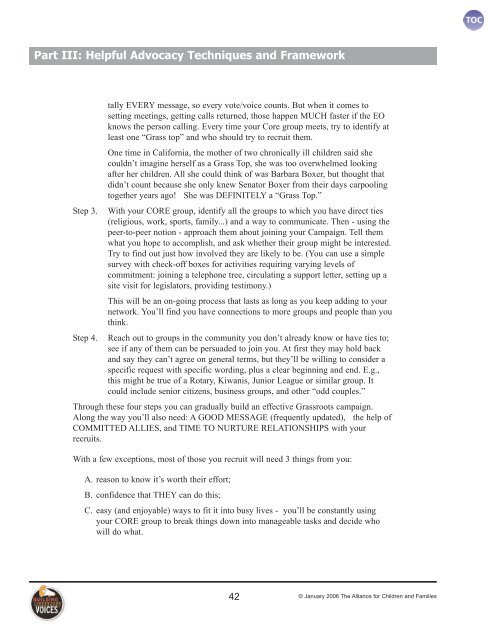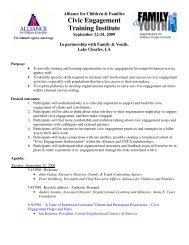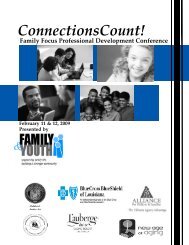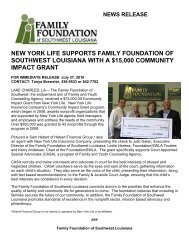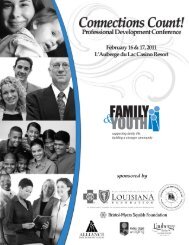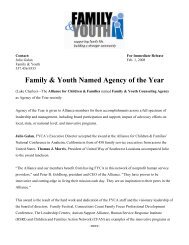Mission-based Advocacy Toolkit from Alliance for Children & Families
Mission-based Advocacy Toolkit from Alliance for Children & Families
Mission-based Advocacy Toolkit from Alliance for Children & Families
Create successful ePaper yourself
Turn your PDF publications into a flip-book with our unique Google optimized e-Paper software.
Part III: Helpful <strong>Advocacy</strong> Techniques and Framework<br />
tally EVERY message, so every vote/voice counts. But when it comes to<br />
setting meetings, getting calls returned, those happen MUCH faster if the EO<br />
knows the person calling. Every time your Core group meets, try to identify at<br />
least one “Grass top” and who should try to recruit them.<br />
One time in Cali<strong>for</strong>nia, the mother of two chronically ill children said she<br />
couldn’t imagine herself as a Grass Top, she was too overwhelmed looking<br />
after her children. All she could think of was Barbara Boxer, but thought that<br />
didn’t count because she only knew Senator Boxer <strong>from</strong> their days carpooling<br />
together years ago! She was DEFINITELY a “Grass Top.”<br />
Step 3. With your CORE group, identify all the groups to which you have direct ties<br />
(religious, work, sports, family...) and a way to communicate. Then - using the<br />
peer-to-peer notion - approach them about joining your Campaign. Tell them<br />
what you hope to accomplish, and ask whether their group might be interested.<br />
Try to find out just how involved they are likely to be. (You can use a simple<br />
survey with check-off boxes <strong>for</strong> activities requiring varying levels of<br />
commitment: joining a telephone tree, circulating a support letter, setting up a<br />
site visit <strong>for</strong> legislators, providing testimony.)<br />
This will be an on-going process that lasts as long as you keep adding to your<br />
network. You’ll find you have connections to more groups and people than you<br />
think.<br />
Step 4. Reach out to groups in the community you don’t already know or have ties to;<br />
see if any of them can be persuaded to join you. At first they may hold back<br />
and say they can’t agree on general terms, but they’ll be willing to consider a<br />
specific request with specific wording, plus a clear beginning and end. E.g.,<br />
this might be true of a Rotary, Kiwanis, Junior League or similar group. It<br />
could include senior citizens, business groups, and other “odd couples.”<br />
Through these four steps you can gradually build an effective Grassroots campaign.<br />
Along the way you’ll also need: A GOOD MESSAGE (frequently updated), the help of<br />
COMMITTED ALLIES, and TIME TO NURTURE RELATIONSHIPS with your<br />
recruits.<br />
With a few exceptions, most of those you recruit will need 3 things <strong>from</strong> you:<br />
A. reason to know it’s worth their ef<strong>for</strong>t;<br />
B. confidence that THEY can do this;<br />
C. easy (and enjoyable) ways to fit it into busy lives - you’ll be constantly using<br />
your CORE group to break things down into manageable tasks and decide who<br />
will do what.<br />
42<br />
© January 2006 The <strong>Alliance</strong> <strong>for</strong> <strong>Children</strong> and <strong>Families</strong>


